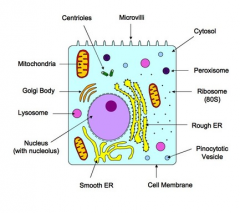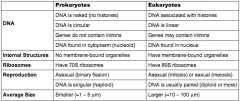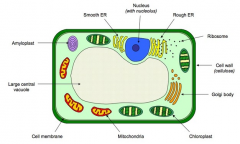![]()
![]()
![]()
Use LEFT and RIGHT arrow keys to navigate between flashcards;
Use UP and DOWN arrow keys to flip the card;
H to show hint;
A reads text to speech;
17 Cards in this Set
- Front
- Back
|
Draw and label a diagram of the ultrastructure of a liver cell as an example of an animal cell |

|
|
|
function of Cell Membrane |
Semi-permeable barrier that controls the entry and exit of substances |
|
|
function of Nucleus |
Contains hereditary material (DNA) and thus controls cell activities (via transcription) and mitosis (via DNA replication) |
|
|
function of Nucleolus |
Site of the production and assembly of ribosome components |
|
|
function of Ribosome |
Complexes of RNA and protein that are responsible for polypeptide synthesis (eukaryotic ribosomes are larger than prokaryotes - 80S) |
|
|
function of Mitochondria |
Site of aerobic respiration, which produces large quantities of chemical energy (ATP) from organic compounds |
|
|
function of Golgi Apparatus |
An assembly of vesicles and folded membranes involved in the sorting, storing and modification of secretory products |
|
|
function of Lysosome |
Site of hydrolysis / digestion / breakdown of macromolecules |
|
|
function of Peroxisome |
Catalyses breakdwon of toxic substances like hydrogen peroxide and other metabolites |
|
|
function of Centrioles |
Microtubule-organising centres involved in cell division (mitosis / meiosis and cytokinesis) |
|
|
function of Endoplasmic Reticulum |
A system of membranes involved in the transport of materials between organelles |
|
|
Function of Rough ER |
Studded with ribosomes and involved in the synthesis and transport of proteins destined for secretion |
|
|
function of Smooth ER |
Involved in the synthesis and transport of lipids and steroids, as well as metabolism of carbohydrates |
|
|
Identify the structures of a eukaryote in electron micrographs of a liver cell |

|
|
|
Compare prokaryote and eukaryote cells |

Similarities: * Both have a cell membrane* Both contain ribosomes * Both have DNA and cytoplasm |
|
|
Draw and label a plant cell |

|
|
|
State three differences between plant and animal cells |

|

